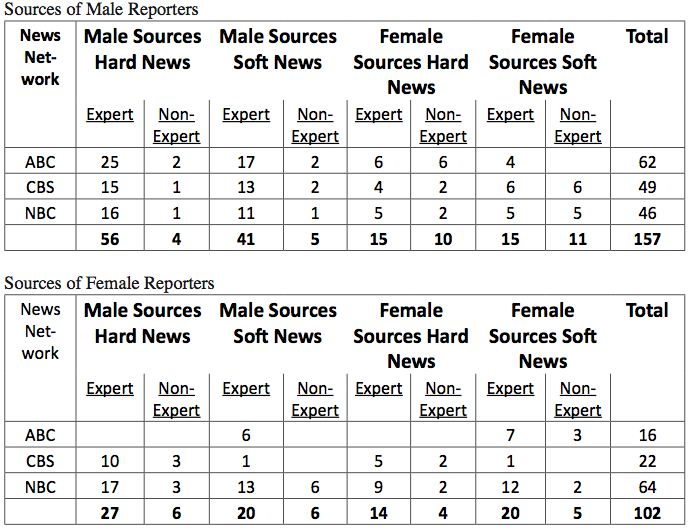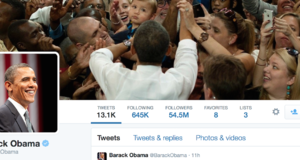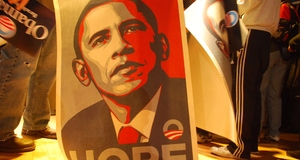From Elon Journal of Undergraduate Research in Communications VOL. 4 NO. 1Women in TV Broadcast News: Reporters and Sources in Hard News Stories
IN THIS ARTICLE
KEYWORDS
AbstractThis study, conducted during a two-week period leading up to the 2012 Presidential Election, analyzed three prime time news broadcasts to determine whether male journalists reported more hard news stories than female journalists throughout a segment of increased political activity and whether male and female sources were used equally in said stories. The results showed that male reporters were assigned more hard news than female reporters, and males were a little more likely to assigned to hard news than soft news. Male sources were used more as experts in hard news by both male and female reporters. Actually female reporters relied on males as expert sources more than male reporters. The implications of the results of this study include female underrepresentation as reporters and sources, probably continuing a perception of women as being in a lower social status than men. I. IntroductionWomen journalists initially had difficulty breaking into the broadcast news field and did not begin to make real strides towards equality until the 1960s and 1970s (Hosley & Yamada, 1987). However, today women still struggle to earn the same advantages men are granted in the newsroom. Women reporters are frequently relegated to soft news stories, like health and entertainment news, whereas their male counterparts are given stories of political and international importance. Supposedly, this is because "the nature of the genre . . . allows for a masculine or feminine style of journalism," but that should not be a permitted excuse to prevent women from being assigned the same, important stories that men are assigned (Carter, 1998, p. 14). Women have also been underrepresented as sources on news programs. Most news stories need to feature an interview with a person discussing the topic of the story, and reporters contact expert sources for their opinions on that topic. Traditionally, male experts are used as sources more often than female experts, and female experts are used less in hard news stories than men. A study of 159 stories broadcast on major news networks showed that female sources were more likely to appear in stories reported by women and that women reported on 53% of social issues. Male reporters, on the other hand, had five and a half male sources for every one female source and they reported on 86% of the foreign policy stories (Liebler & Smith, 1997). If women sources are unable to be considered professionals or experts in stories of national or international importance, viewers could be led to believe that women do not deserve leadership roles. As women reporters continue to be assigned soft news stories, women sources will continue to be inadequately utilized in hard news stories (Armstrong, 2004). One of the biggest hard news stories of this year has been and will continue to be the 2012 Presidential Election. The news cycles on most big news channels continue to be politically heavy, which, in theory, could give women journalists ample opportunity to work on hard news stories if there are more to report. What this study aimed to find was whether, with so many hard news stories to go around, women are still being pushed into the traditionally "feminine" human-interest stories, or if the political climate will give them a greater opportunity to match their male counterparts. Although the political field provides fewer female than male pundits, not to mention fewer females in government positions, will female sources be portrayed professionally in news stories as male sources usually are? II. Literature ReviewA majority of studies showed that women are generally considered less capable of relaying news and events than their male colleagues, which could be seen as backward considering that today more females consume news than males. Personal views are continually shaped through consumption of mass media, which could lead one to assume that society will reinforce a "lower public status for women relative to men" (Armstrong, 2004, p. 140) as fewer women journalists or sources are shown in news coverage. Women have been fairly successful in breaking into the news business. In the late 1970s and early 1980s, only 13% of reporters were women, whereas today about half of reporters are women. However, women are still far from equality as they face professional barriers of appearance and age. One study found that although female reporters presenting news stories were perceived as being more credible than male reporters presenting similar stories, male reporters were seen as being more credible persons overall. However, the gender of the news viewer also has to be considered; generally, recipients find reporters of his or her same gender to be credible. Another noticeable finding from this study was that although young reporters' credibility was not influenced by age, the older, male reporters were considered to be the most credible reporters (Weibel, Wissmath, & Groner, 2008). Other research found that age impacts the length of news segments: younger women are often in shorter news segments than other, more experienced female journalists. When comparing older women reporters to males in the same age range, one can see the trend that men are able to have longer careers because women become "too old, too unattractive . . . not sufficiently deferential to men" (Armstrong, 2010, p. 83). Another disparity between male and female journalists is the level of sexuality they must display in order to be a featured newscaster. A study of cable news programs found that 62% of segments analyzed contained predominately female journalists with high sex appeal. "Specifically, these journalists were physically attractive, suggestively dressed (e.g., open blouses, tight-fitting skirts), and filmed in ways that accentuated these features" (Nitz, Reichert, Aune, & Velde, 2007, p. 14). The fact that news networks use these tactics to appeal to viewers suggested that said networks are more interested in entertaining and marketing than news. Another result from the study showed that, despite being overtly sexualized for viewer entertainment, female journalists still reported hard news stories, proving that "sexualization was present in all types of news, regardless of the topic's seriousness" (Nitz et al., 2007, p. 23). But, again, this study showed that women are unequal to men. Out of all of the news stories considered to have a sexually appealing reporter, 94% of those reporters were female. When studied through an audience perspective, these journalists had the potential to influence attitudes about sexuality and gender, but it shouldn't be that a woman's value is reliant on her sexual appeal (Nitz et al., 2007). These obstacles are partially to blame for the mindset that female journalists should be relegated to reporting on soft news only. Another determinant of the type of news a female journalist covers is whether she works for a local or network news program; female journalists on local newscasts are able to cover hard and soft news stories more often than those on national broadcast programs (Armstrong, 2010). Although women are on air on local programs more often than women on network programs, they still are responsible for 48% of soft stories and only 28% of hard stories. Comparatively, at networks, women present 16% of hard stories and 14% of soft ones; overall, both percentages are still low compared to the amount and type of stories men report (Hosley & Yamada, 1987). A study in 1987 on network television news found that, out of 216 stories, males covered 191 of those stories and the remaining 25 went to females. During the same time period, males reported 369 stories regarding government officials, eight times as many stories as females on the same topic (Ziegler & White, 1990). Roger Desmond and Anna Danilewicz (2010) identified another gender discrepancy in terms of news sources. Female reporters were more likely to report on human interest and health stories, while males reported on politics. Within those stories, males were more often cited as experts and sourced more frequently than female experts, while there were no major differences between male and female non-experts. Reporters were often more likely to choose a source of their own gender, which therefore gave male sources more prominence as there were more male reporters addressing hard news issues (Craft & Wanta, 2004). It could also be said that female reporters seek out female sources because they are typically underrepresented, except for in human interest and similar soft news stories presumably written specifically for their gender. For this research, the author established two hypotheses:
Suggested Reading from Inquiries Journal
Inquiries Journal provides undergraduate and graduate students around the world a platform for the wide dissemination of academic work over a range of core disciplines. Representing the work of students from hundreds of institutions around the globe, Inquiries Journal's large database of academic articles is completely free. Learn more | Blog | Submit Latest in Business & Communications |


















